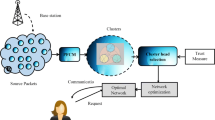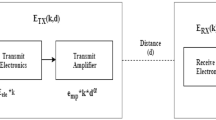Abstract
Wireless Sensor Network (WSN) is generally considered as a standout amongst the most critical advancements for the twenty-first century, it normally comprises multifunctional wireless sensor nodes, with detecting, communications, and calculation capacities. Clustering the random nodes in WSN is a challenging task with high performance. This paper presents the new clustering model to monitor the eco-friendly mobile network by clustering the sensor nodes and to enhance the Quality of Service of that optimal network in WSN. The proposed Multi-Objective Weighted Clustering model groups the arbitrary nodes and afterward the optimal network is achieved by the optimization of network parameters. For optimizing the network parameters, a metaheuristic algorithm i.e. Improved Fruit Fly Optimization is introduced. With the goal of assessing the Coverage Efficiency (CE) and network user satisfaction of the accomplished optimal mobile network in WSN, the remote sensor monitoring process is applied. Sensor monitoring helps to know the network users and furthermore to improve the CE of WSN, contrasted with existing work.











Similar content being viewed by others
References
Abdolmaleki, N., Ahmadi, M., Malazi, H. T., & Milardo, S. (2017). Fuzzy topology discovery protocol for SDN-based wireless sensor networks. Simulation Modelling Practice and Theory, 79, 54–68.
Ahmed, G., Zou, J., Fareed, M. M. S., & Zeeshan, M. (2016). Sleep-awake energy efficient distributed clustering algorithm for wireless sensor networks. Computers & Electrical Engineering, 56, 385–398.
Althunibat, S., Khalifeh, A., & Mesleh, R. (2018). A low-interference decision-gathering scheme for critical event detection in clustered wireless sensor network. Physical Communication, 26, 149–155.
Alumona, T. L., Idigo, V. E., & Nnoli, K. P. (2014). Remote monitoring of patients health using wireless sensor networks (WSNs). IPASJ International Journal of Electronics & Communication, 2(9), 90–95.
Bozorgi, S. M., Rostami, A. S., Hosseinabadi, A. A. R., & Balas, V. E. (2017). A new clustering protocol for energy harvesting-wireless sensor networks. Computers & Electrical Engineering, 64, 233–247.
Chatei, Y., Ghoumid, K., Hammouti, M., & Hajji, B. (2017). Efficient coding techniques algorithm for cluster-heads communication in wireless sensor networks. AEU-International Journal of Electronics and Communications, 82, 294–304.
Chen, D. R. (2015). A link-and hop-constrained clustering for multi-hop wireless sensor networks. Computer Communications, 72, 78–92.
Deepa, O., & Suguna, J. (2017). An optimized QoS-based clustering with multipath routing protocol for wireless sensor networks. Journal of King Saud University-Computer and Information Sciences, 32(7), 763–774. https://doi.org/10.1016/j.jksuci.2017.11.007.
Deif, D., & Gadallah, Y. (2015, December). Wireless Sensor Network deployment using stochastic optimization techniques-a comparative study. In Computing and Network Communications (CoCoNet), 2015 International Conference on (pp. 131–138). IEEE.
Elhoseny, M., Tharwat, A., Yuan, X., & Hassanien, A. E. (2018). Optimizing K-coverage of mobile WSNs. Expert Systems with Applications, 92, 142–153.
Gupta, G. P., & Jha, S. (2018). Integrated clustering and routing protocol for wireless sensor networks using Cuckoo and Harmony Search based metaheuristic techniques. Engineering Applications of Artificial Intelligence, 68, 101–109.
Hacioglu, G., Kand, V. F. A., & Sesli, E. (2016). Multi objective clustering for wireless sensor networks. Expert Systems with Applications, 59, 86–100.
Jovanovic, M. D., Stojanovic, I. Z., Djosic, S. M., & Djordjevic, G. L. (2016). Intra-cluster tone-based contention resolution mechanism for wireless sensor networks. Computers & Electrical Engineering, 56, 485–497.
Khedo, K. K., Perseedoss, R., & Mungur, A. (2010). A wireless sensor network air pollution monitoring system. arXiv preprint arXiv:1005.1737.
Lakshmi, N. S. R., Babu, S., & Bhalaji, N. (2017). Analysis of clustered QoS routing protocol for the distributed wireless sensor network. Computers & Electrical Engineering, 64, 173–181.
Mann, P. S., & Singh, S. (2017). Improved metaheuristic based energy-efficient clustering protocol for wireless sensor networks. Engineering Applications of Artificial Intelligence, 57, 142–152.
Mirzaie, M., & Mazinani, S. M. (2017). Adaptive MCFL: An adaptive multi-clustering algorithm using fuzzy logic in wireless sensor network. Computer Communications, 111, 56–67.
Moh’d Alia, O. (2017). Dynamic relocation of mobile base station in wireless sensor networks using a cluster-based harmony search algorithm. Information Sciences, 385, 76–95.
Mujica, G., Portilla, J., & Riesgo, T. (2015). Performance evaluation of an AODV-based routing protocol implementation by using a novel in-field WSN diagnosis tool. Microprocessors and Microsystems, 39(8), 920–938.
Narawade, V., & Kolekar, U. D. (2018). ACSRO: adaptive cuckoo search based rate adjustment for optimized congestion avoidance and control in wireless sensor networks. Alexandria Engineering Journal, 57, 131–145.
Oladimeji, M. O., Turkey, M., & Dudley, S. (2017). HACH: Heuristic Algorithm for Clustering Hierarchy protocol in wireless sensor networks. Applied Soft Computing, 55, 452–461.
Ouchitachen, H., Hair, A., & Idrissi, N. (2017). Improved multi-objective weighted clustering algorithm in Wireless Sensor Network. Egyptian Informatics Journal, 18, 45–54.
Pan, W. T. (2012). A new fruit fly optimization algorithm: taking the financial distress model as an example. Knowledge-Based Systems, 26, 69–74.
Ram, S. S., Nedic, A., & Veeravalli, V. V. (2007). Stochastic incremental gradient descent for estimation in sensor networks. In Signals, Systems and Computers, 2007. ACSSC 2007. Conference Record of the Forty-First Asilomar Conference on (pp. 582–586). IEEE.
Rekha, K. S., Sreenivas, T. H., & Kulkarni, A. D. (2018). Remote monitoring and reconfiguration of environment and structural health using wireless sensor networks. Materials Today: Proceedings, 5, 1169–1175.
Rotariu, C., Bozomitu, R. G., Cehan, V., Pasarica, A., & Costin, H. (2015). A wireless sensor network for remote monitoring of bioimpedance. In Electronics Technology (ISSE), 2015 38th International Spring Seminar on IEEE, 487–490.
Shokouhifar, M., & Jalali, A. (2017). Optimized sugeno fuzzy clustering algorithm for wireless sensor networks. Engineering applications of artificial intelligence, 60, 16–25.
Song, C., & Fan, Y. (2018). Coverage control for mobile sensor networks with limited communication ranges on a circle. Automatica, 92, 155–161.
Sundararaj, V., Muthukumar, S., & Kumar, R. S. (2018). An optimal cluster formation based energy efficient dynamic scheduling hybrid MAC protocol for heavy traffic load in wireless sensor networks. Computers & Security, 77, 277–288.
Van Khoa, V., & Takayama, S. (2018). Wireless sensor network in landslide monitoring system with remote data management. Measurement, 118, 214–229.
Xu, X., Liang, W., & Xu, Z. (2014). Remote monitoring cost minimization for an unreliable sensor network with guaranteed network throughput. Information Processing in Agriculture, 1(2), 83–94.
Zhang, L., Cai, L. B., Li, M., & Wang, F. H. (2009). A method for least-cost QoS multicast routing based on genetic simulated annealing algorithm. Computer Communications, 32, 105–110.
Author information
Authors and Affiliations
Corresponding author
Additional information
Publisher's Note
Springer Nature remains neutral with regard to jurisdictional claims in published maps and institutional affiliations.
Rights and permissions
About this article
Cite this article
Thekkil, T.M., Prabakaran, N. Optimization Based Multi-Objective Weighted Clustering For Remote Monitoring System in WSN. Wireless Pers Commun 117, 387–404 (2021). https://doi.org/10.1007/s11277-020-07874-2
Accepted:
Published:
Issue Date:
DOI: https://doi.org/10.1007/s11277-020-07874-2




